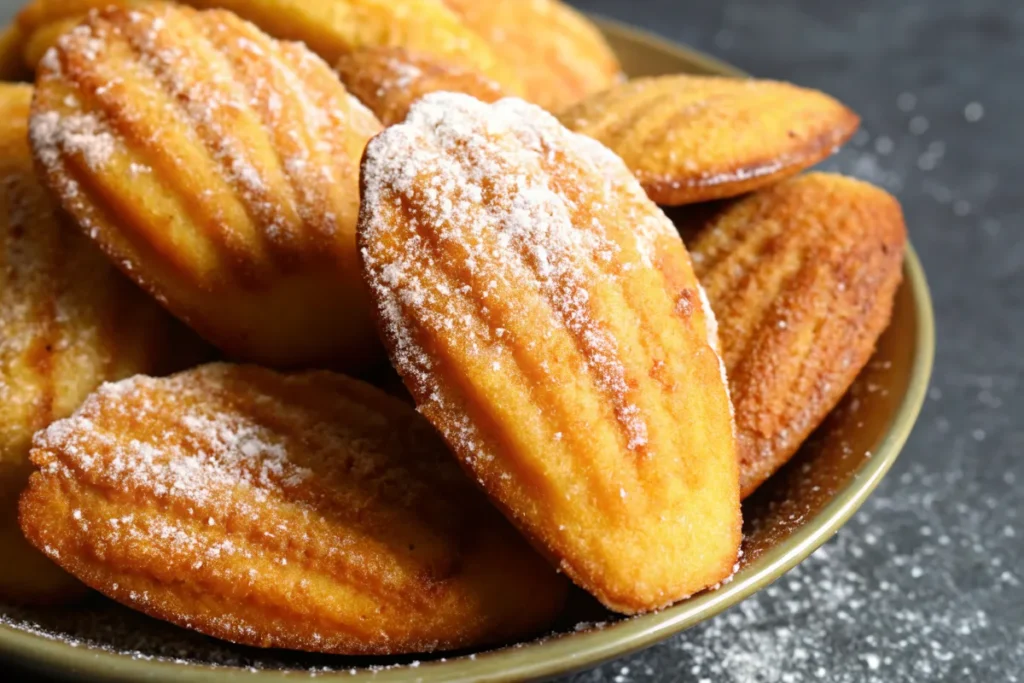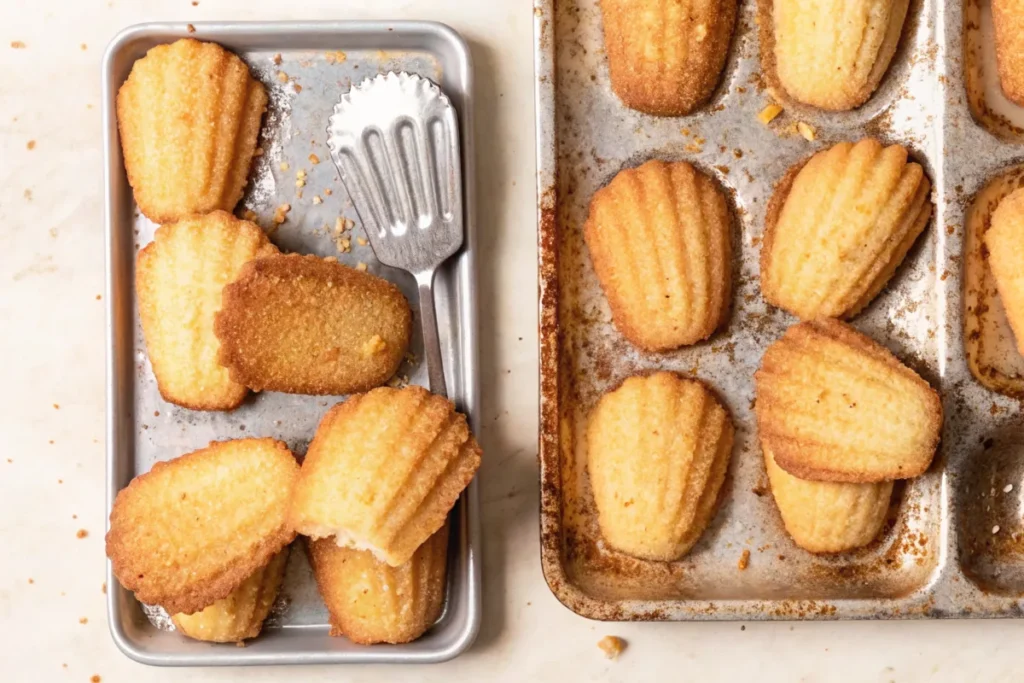Secrets to Getting the Signature Madeleine Hump aren’t just whispers passed down in fancy French patisseries—they’re a blend of science, timing, and a few key techniques that every home baker can master. That adorable little bump on top of a madeleine isn’t just a visual delight—it’s a hallmark of proper preparation. But let’s be honest: getting that signature rise isn’t always easy. You might follow the recipe to the letter and still end up with a batch of sad, flat cookies.
In this guide, we’re cracking open the mystery of that iconic hump and showing you exactly how to replicate it—every single time. Whether you’re a seasoned baker or just trying madeleines for the first time, we’ll walk you through the exact steps, tools, and tips to nail it. From understanding the science behind the rise to tweaking your batter technique and oven setup, we’ve got it all covered. Plus, you’ll learn how to add bold flavors like lemon, chocolate, or spice without sabotaging the puff.
Learn more about madeleine flavor twists and techniques to complement your baking journey. Ready to finally achieve that golden, puffy perfection? Let’s dive in.
Print
Secrets to Getting the Signature Madeleine Hump: Proven Baking Tricks
- Total Time: 25–27 minutes (plus chilling time)
- Yield: 12 madeleines 1x
Description
These Orange Madeleines are delicate, buttery French sponge cookies infused with the bright, citrusy aroma of fresh orange zest. Each one features the iconic madeleine hump—a signature of perfectly executed technique. With crisp golden edges and pillowy-soft centers, these little shell-shaped treats are perfect for tea time, holidays, or a refined afternoon snack. Master the secrets to getting the perfect rise, all while savoring a bold twist on a French classic.
Ingredients
2 large eggs, room temperature
1/2 cup (100g) granulated sugar
Zest of 1 large orange (preferably organic)
1 tsp pure vanilla extract
3/4 cup (95g) all-purpose flour
1 tsp baking powder
1/4 tsp salt
1/2 cup (113g) unsalted butter, melted and cooled
Powdered sugar (optional, for dusting)
Instructions
In a large mixing bowl, whisk together the eggs and sugar for 4–5 minutes, until pale, thick, and ribbon-like.
Add the orange zest and vanilla extract. Gently whisk to combine.
In a separate bowl, whisk together the flour, baking powder, and salt.
Sift the dry ingredients into the egg mixture and gently fold to combine—do not overmix.
Slowly stream in the melted, cooled butter while folding gently. Mix just until incorporated.
Cover the batter and chill in the refrigerator for at least 1 hour (overnight preferred).
Preheat oven to 425°F (218°C). Grease and lightly flour a madeleine pan.
Spoon 1 tablespoon of chilled batter into the center of each mold—no need to spread it.
Bake for 5 minutes, then reduce oven to 375°F (190°C) and bake an additional 5–6 minutes, until golden with a visible hump.
Let cool in the pan for 2 minutes, then transfer to a wire rack. Dust with powdered sugar if desired
Notes
For extra orange depth, use orange extract in place of vanilla.
To prevent sticking, make sure your pan is well-greased and floured or use baking spray with flour.
Madeleines are best enjoyed the day they’re baked but can be stored in an airtight container for 2–3 days.
Want chocolate-orange? Swap 1 tbsp flour for cocoa powder and keep the zest!
- Prep Time: 15 minutes
- Cook Time: 10–12 minutes
- Category: Dessert
- Method: Dessert / Tea Cake
- Cuisine: French
Nutrition
- Serving Size: 2 madeleines
- Calories: ~140 per serving
- Fat: ~8g
- Carbohydrates: ~15g
- Protein: ~2g
Understanding the Madeleine Hump
What Is the Signature Madeleine Hump?
The madeleine hump isn’t just a cute characteristic of this classic French shell-shaped treat—it’s a badge of honor. It tells the world you followed the method just right. But what exactly is it? The hump is the raised dome that forms on the back of a madeleine as it bakes, giving it that distinct, puffed-up look. Without it, your cookies may taste fine, but visually, they’ll fall short of authentic.
In the secrets to getting the signature madeleine hump, understanding its origin is crucial. This rise happens when chilled batter meets intense heat—causing a burst of steam that pushes the center upward before the edges finish baking. The contrast in temperature is the driving force, but your ingredient ratios, pan prep, and even your patience also play into it.
Why Is It So Desired in Classic French Baking?
There’s something deeply satisfying about pulling madeleines from the oven and seeing that perfect dome. It’s not just for aesthetics either. That hump creates a lighter texture on the inside while preserving a crispy edge outside—exactly how traditional madeleines are meant to be.
Many bakers believe that mastering the hump is part of mastering French baking itself. When you understand the secrets to getting the signature madeleine hump, you’re not just baking cookies—you’re honoring centuries of pastry tradition. It’s also a visual cue for success: no hump? Something probably went wrong. And we’re here to help make sure that never happens again.
Want to experiment beyond the classic look? Discover great ideas like madeleine flavor variations that maintain the hump while expanding your taste range.
The Science Behind the Madeleine Hump
How Temperature Shock Creates the Bump
At the heart of the secrets to getting the signature madeleine hump lies a bit of simple kitchen science. When you refrigerate the batter and then place it into a hot oven, the extreme shift in temperature causes a rapid steam release. This sudden expansion is what drives the batter upwards before it settles.
Without this temperature shock, your madeleines bake evenly—but that’s not what you want here. You’re aiming for controlled chaos: chilled batter, hot oven, and a perfectly timed bake that encourages the center to puff. If your batter isn’t cold enough or your oven isn’t properly preheated, your madeleines won’t rise. It’s that delicate balance that’s at the core of all secrets to getting the signature madeleine hump.
The Role of Leavening Agents in Madeleines
While some recipes lean into whipped egg techniques alone, most modern madeleine methods include a bit of baking powder. This gives the batter the extra push it needs when that temperature shock hits. But it’s not about dumping in a lot—it’s about precision. Too much leavening, and you’ll get a weird-shaped hump or air bubbles in all the wrong places.
The secrets to getting the signature madeleine hump include balancing your ingredients just right. Whipping your eggs and sugar until thick and pale provides a natural lift, while the small amount of baking powder gives insurance. If you skip either, you might still get rise—but it won’t be the same proud dome that a French chef would nod at.
Don’t miss our ultimate chocolate cake guide if you want to dig deeper into the science of rise and fluff in baked goods.
Mastering the Madeleine Batter
Why Proper Mixing Technique Matters
When it comes to the secrets to getting the signature madeleine hump, it all starts in the bowl. How you mix your ingredients will make or break your batch. Many bakers rush this step, but the key is to whisk the eggs and sugar until thick, pale, and ribbon-like. This builds the structure and airiness your madeleines need to rise dramatically in the oven.
Gently folding in the flour and melted butter without deflating the batter is equally critical. Overmix, and you lose volume. Undermix, and you’ll get clumps or uneven texture. Think of this step as the foundation of everything—if your batter isn’t just right, the hump simply won’t happen.
In the secrets to getting the signature madeleine hump, this step is often overlooked, yet it’s one of the most decisive.
Chilling Time: The Secret Weapon for the Hump
Ask any seasoned French baker and they’ll tell you—cold batter is non-negotiable. One of the most important secrets to getting the signature madeleine hump is chilling your batter for at least an hour (and ideally, overnight). Why? Because it firms up the butter and thickens the batter, allowing that coveted temperature shock to work its magic in the oven.
Cold batter also prevents premature spreading. Instead of flattening out, the batter rises upward. That’s the hump you’re aiming for. Skipping this step is one of the fastest ways to sabotage your results.
If you want consistent success, remember: cold batter + hot oven = signature bump. This rule is baked right into the secrets to getting the signature madeleine hump, and it’s one you simply can’t ignore.

Check out our cookie dough bite technique to see how chill time can elevate all kinds of baked goods.
Tools and Equipment for Perfect Madeleines
Best Madeleine Pans: Traditional vs. Modern Options
One of the most practical secrets to getting the signature madeleine hump is using the right pan. While it may seem tempting to improvise, the classic shell-shaped madeleine pan is designed to cradle the batter in a way that promotes upward expansion. Non-stick metal pans are widely used, but traditional tin or heavy-duty steel pans often produce better results due to more even heat distribution.
Silicone pans, while easier to clean, don’t conduct heat as efficiently. This means the temperature shock we talked about? It won’t be as dramatic, and the hump may suffer. If you’re serious about your cookies, invest in a quality pan—it’s a silent partner in all your secrets to getting the signature madeleine hump.
Can You Bake Madeleines Without a Madeleine Pan?
Yes, but with a caveat. If you don’t have the classic mold, you can use mini muffin tins or even cupcake pans in a pinch. However, these alternatives won’t produce the iconic ridged back or the same dome rise. The batter will bake, sure—but the results may lack the authenticity and charm that define madeleines.
Still, if you’re practicing or experimenting with flavors, it’s better to bake than to wait. Just remember that not using the traditional pan does make it harder to achieve that perfect bump, a core element of the secrets to getting the signature madeleine hump.
Looking for inspiration? Try our boston cream cupcakes for creative baking ideas with different molds.
Baking Techniques to Achieve the Hump
Preheating, Temperature Settings & Oven Placement
Precision baking is a key piece of the secrets to getting the signature madeleine hump. The first rule? Preheat your oven properly—at least 20 minutes in advance. Madeleines require a hot start to shock the batter into rising, so you’ll want your oven blazing at 425°F (218°C). After 5 minutes, reduce the temperature to 375°F (190°C) to finish baking without overbrowning.
Oven placement matters too. Bake on the middle rack to ensure even airflow and heat distribution. Placing the tray too high can brown the tops too fast, while a lower rack might underbake the centers. Part of the secrets to getting the signature madeleine hump is respecting the heat and using it wisely.
Timing Is Everything: Baking Duration Tips
You’d be surprised how a minute or two can make or break your batch. Most madeleines are ready in 10 to 12 minutes, but the real magic happens in the first five. That’s when the hump forms. Opening the oven too early or overbaking will collapse your cookies or dry them out.
The secrets to getting the signature madeleine hump involve trusting the process. Set a timer. Watch for the golden edges and puffed centers. A perfectly baked madeleine should spring back when lightly touched.
Don’t miss our ultimate chocolate cake guide for more timing tricks across delicate desserts.
PART 6: Ingredient Secrets to Enhance Rise
Key Ingredients That Encourage a Bump
You don’t need a massive ingredient list to get the signature dome—just the right ones in the right ratios. Eggs are essential. They provide structure and lift when whipped properly. Sugar adds stability to the whipped eggs. Butter adds richness but also needs to be cooled before folding in, so it doesn’t deflate the mix.
Baking powder plays a supporting role in the secrets to getting the signature madeleine hump, giving your batter an extra push. But remember—it’s balance over excess. Too much, and you’ll get a lopsided hump or a hollow center.
What Not to Use: Ingredients That Weigh Down Batter
It’s tempting to get creative, but heavy add-ins like chopped nuts, thick jams, or dense flours can ruin your rise. These extras interfere with the aeration of the batter and fight against the rise you’ve worked so hard to achieve. If you do want to add flavors, go for finely grated citrus zest or extracts—they bring boldness without bulk.
Part of the secrets to getting the signature madeleine hump is knowing what to leave out just as much as what to include. Clean, simple ingredients paired with technique are your best bet.

Discover great ideas like madeleine variations that won’t sacrifice the hump.
Troubleshooting Madeleine Hump Issues
Why Didn’t My Madeleines Rise?
You’ve followed the recipe, used the right pan, and yet… flat cookies? Don’t worry—this is common. One of the biggest baking letdowns is a missing hump. The reasons often come down to three things: your batter wasn’t cold enough, the oven wasn’t hot enough, or you overmixed the ingredients.
The secrets to getting the signature madeleine hump emphasize prep just as much as baking. If your batter was too warm, it likely spread before it had a chance to lift. If your oven wasn’t fully preheated, that initial heat burst never happened. And if you overworked the batter, you may have deflated the trapped air needed for a rise.
To troubleshoot effectively, always go back to the basics. Check your chilling time, oven calibration, and mixing steps. Sometimes it’s just a small tweak that makes all the difference.
Flat vs. Humpy: What Went Wrong?
Still getting flat madeleines? Compare your process to the secrets to getting the signature madeleine hump checklist:
| Problem | Likely Cause | Quick Fix |
|---|---|---|
| Flat tops | Batter too warm | Chill 2+ hours |
| Lopsided hump | Uneven oven heat | Rotate tray halfway |
| No hump | Oven not hot enough | Start at higher temp |
| Sunken center | Overmixed batter | Whisk gently, fold slow |
Mastering this takes practice. Each failed batch teaches you something. Keep baking and refining.
Check out our troubleshooting desserts guide for more baking recovery tips!
Flavor Variations That Don’t Sacrifice the Hump
How to Add Flavors Without Affecting Rise
Many bakers worry that changing the flavor means risking the hump. But don’t stress—it’s possible to enhance taste without losing rise. In fact, the secrets to getting the signature madeleine hump allow for creativity—as long as you stay smart about your add-ins.
Use extracts like vanilla, almond, or citrus. Add grated zest or infused sugar. Want to go bold? Try a touch of matcha or cocoa powder, but make sure to reduce the flour slightly to balance things out. The key is not to overload the batter. You’re aiming for subtle enhancements, not weighty additions.
Popular Variations: Citrus, Chocolate, and Spice
Here are flavor combos that honor the secrets to getting the signature madeleine hump:
- Lemon Zest + Vanilla: Classic and light, great for spring.
- Cocoa + Orange Extract: Deep and rich without affecting texture.
- Chai Spice + Honey: Warm, spiced undertones that pair well with tea.
These options all maintain batter integrity, ensuring your rise stays intact. You don’t have to choose between flavor and form—you can absolutely have both.
Don’t miss our flavor inspiration guide to experiment safely and deliciously.
Madeleines Taste and Texture Guide
What Does a Proper Madeleine Taste Like?
Madeleines are unlike any other cookie—and that’s part of their charm. A classic madeleine has a delicate sweetness, a soft, almost sponge-like interior, and a buttery richness with hints of vanilla or citrus. That little hump? It’s not just for looks—it influences taste and texture too.
In the secrets to getting the signature madeleine hump, you’ll learn that the hump helps create two textures in one cookie: crispy golden edges and a pillowy-soft center. When made right, they’re light, elegant, and almost melt in your mouth. Any bitterness or dryness? That’s a sign something went wrong.
The flavor should be subtle and refined. A proper madeleine doesn’t punch—it whispers. That’s what makes it ideal with tea or coffee.
Texture Expectations: Crispy Edges, Tender Centers
One of the key insights in the secrets to getting the signature madeleine hump is how the shape and rise create the perfect mouthfeel. The raised hump allows the edges to firm up and brown, while protecting the center from overbaking. This results in that iconic contrast: a light crust with a moist, tender crumb.
When madeleines fall flat, the texture suffers. The inside becomes dense, even rubbery, and the crisp edge disappears. The bump isn’t just visual flair—it’s part of the structure that makes these cookies stand out in the pastry world.
Want proof? Take a look at this close-up of the crumb structure in a well-made madeleine:
Looking for inspiration? Try our boston cream cupcakes for another dessert with satisfying texture contrasts.
FAQs
How to get the bump on madeleines?
The bump forms when chilled batter hits a hot oven, creating a steam burst that pushes the center upward. To nail it, chill the batter for at least an hour and bake at high heat (425°F), then reduce the temp mid-bake.
Why do madeleine cookies have a bump?
The iconic bump is a result of temperature shock—cold batter meets a hot oven. This causes rapid expansion in the center while the edges set, creating that classic dome.
What does madeleine taste like?
A madeleine tastes buttery, light, and slightly sweet with a delicate crumb. Common flavors include vanilla, lemon, and almond, depending on the recipe.
What can I use instead of a madeleine pan?
You can substitute with mini muffin tins or shallow tart pans, though you’ll lose the shell shape and possibly the signature bump. For best results, use a traditional madeleine mold.
Learn more about madeleine recipe technique to master every step like a pro.
Conclusion
Mastering the secrets to getting the signature madeleine hump isn’t about luck—it’s about precision, patience, and practice. From mixing the batter just right, to chilling it long enough, and baking it with care, every step plays a role. And while it may seem small, that puffed-up bump is a symbol of true baking technique.
Now that you understand the science, the tools, and the tips behind it, you’re ready to take your madeleines to the next level. Remember, even if your first batch isn’t perfect, each attempt brings you closer to that ideal hump. And once you get it, you’ll never settle for flat cookies again.
Looking to master more baking skills? Don’t miss our complete madeleine recipe hub for more techniques, variations, and flavor ideas.
